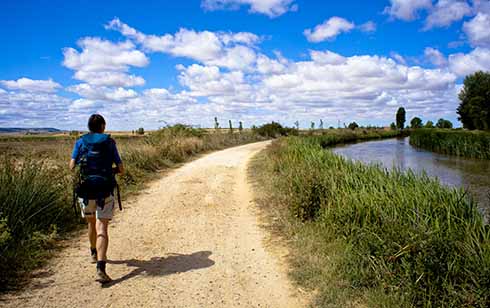 As we move out of lockdown we look forward to being more active and mobile – to begin wandering again.
As we move out of lockdown we look forward to being more active and mobile – to begin wandering again.
Some people have found the past two months limiting and frustrating. Some have begun new hobbies while others have found innovative ways to continue their passions.
As we create a vision of these future activities let us contemplate what we may learn from others who wandered often throughout their lives.
LESSONS FROM ST IGNATIUS
Recovering from a battle injury that shattered his right leg, St Ignatius, for the most part, spent his entire period of convalescence in his room. He was literally unable to move and had limited access to books or visitors. In a similar way to our ‘lock down’, Ignatius grew restless and dreamed of a changed future. He resolved to go on a pilgrimage guided by God. His long pilgrimage prepared and formed him.
In travelling 630km he had much time to observe creation and converse with God. At the conclusion of his pilgrimage he spent many months in Manresa where he received numerous mystical experiences and wrote the Spiritual Exercises.
Interestingly, the image of Ignatius toiling along the trail with his journal, sandals and walking stick is wrong. For all but the last 30km, Ignatius rode a mule as his leg was still healing and for the most part immobilised. After his time at Manresa his pilgrimage to Jerusalem was completed almost entirely on a ship. Our modern understanding of his pilgrimage is incomplete and narrow.
Ignatius’ pilgrimage is not diminished due to his method of transport. His family were wealthy and he was able to take a mule so that he might complete his pilgrimage. The urgency of his desire to begin his pilgrimage before his leg had fully healed ruled out walking.
SPIRITUAL TRANSFORMATION
His long journey is barely noted in his autobiography, but the time spent completing this holy mission confirmed his desire and transformed him spiritually. What we can learn from these observations is that pilgrimage is not about the length of the journey or how we undertake it. The critical aspect of a pilgrimage is the intent and desire required to achieve the transformation promised.
Jesus was a great pilgrim. Everywhere he went he walked. Every step was intentional and deliberate. His desire was to spread the Good News and transform society completely. His journeys were often communal with the Apostles and disciples travelling with him from place to place. Like Ignatius’ pilgrimage the journeys Jesus undertook during his ministry are barely recorded in the Gospels.
In the Gospels there are only two accounts that focus on the wandering involved. Jesus’ torment as he carried his cross and the encounter on the Road to Emmaus. Although when considered even though the journey is described in some detail the key point in each case is the result; Jesus’s crucifixion and his affirmation of the ‘real presence’ in the Eucharist. What is recorded in great detail throughout the Gospels are the moments of teaching and healing.
JOURNEYS OF ENCOUNTER WITH GOD
As restrictions are eased and we begin being more active, or simply being moving again, resolve to change the way we encounter travel and exercise. When you start driving for work or to visit family or friends do so with an openness to the image of God found in Creation and each living thing. Be curious and actively seek God in your journey. Where are the traces of God to be found when you are driving to work? Begin your journey with a desire to encounter God.
Throw away thoughts of being late, delays due to road works or the fact that the increased traffic is ‘slowing you down’. Your desire will change a commute to a pilgrimage. Remember that Ignatius’ great pilgrimage was not about his method of transport but the intent of his journey.
Regardless of the speed your exercise is completed at or the method of transport involved being aware during the journey is essential to living a life filled with encounter. God does not show up only in a beautiful sunset. He surrounds us and is found in all things. Even in the drive to the lookout where we see him a little more easily in the beauty of the sun set.
UNITENTIONAL PILGRIMAGE
Remembering the journey is a lesson for life. If you remember the journey you have wandered. Wandering is beautiful and sneaky occupation. Wandering will, without effort, conclude in a transformative event or encounter. The simple desire to observe a journey will lead to an unintentional pilgrimage. With the desire to find God each moment and through observing with open eyes each journey and in fact every moment can be filled with God’s presence.
As we conclude Laudato si’ week I encourage you to go out and wander. Seek God and remember each journey. In this way your life will become a pilgrimage made up of innumerable journeys where God is and was always present.
Brendan Nicholls, Liturgy Coordinator, St Ignatius College, Geelong
Image: Way of St James, pilgrimage walk, Spain. depositphotos.com